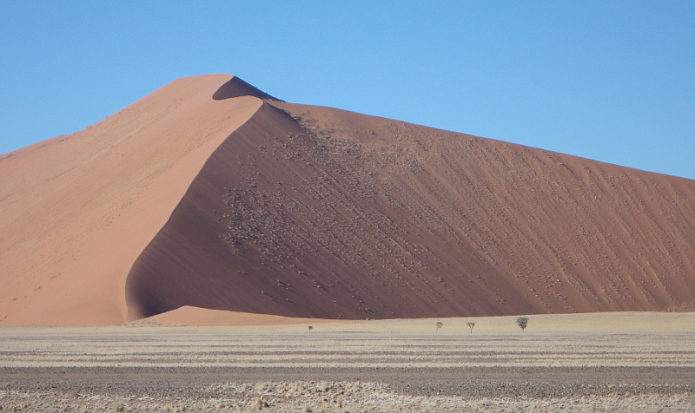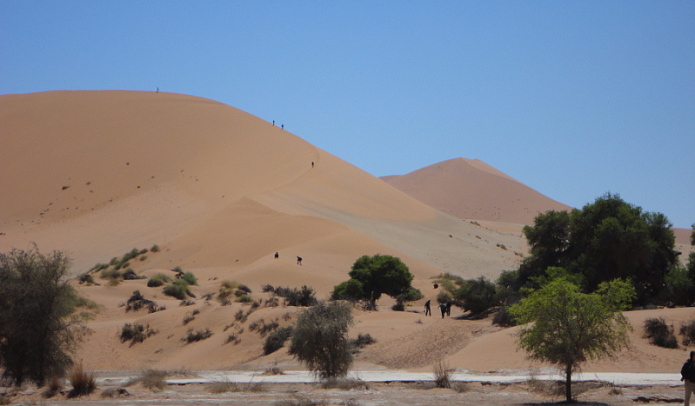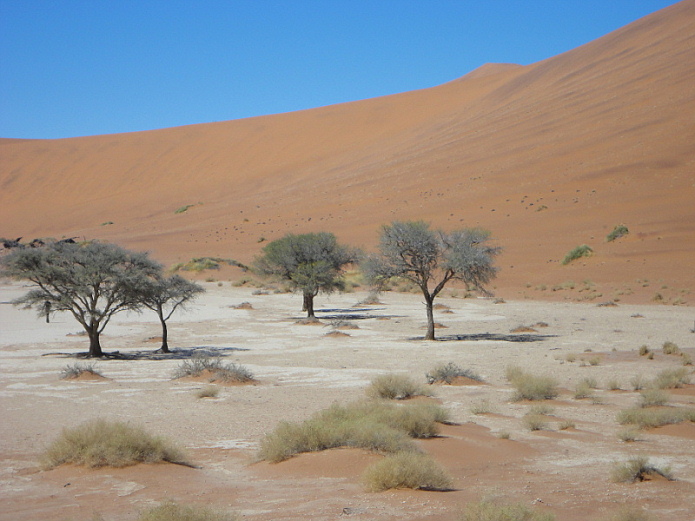Sossusvlei in the Namib-Naukluft National Park of Namibia (part of the Namib Desert) is an endorheic drainage basin (i.e., a drainage basin without outflows) for the ephemeral Tsauchab River.

The Tsauchab carries water only during the rare times when rain falls in the Naukluft Mountains. During these rains, the Tsauchab becomes a rapid-running, strong river within a matter of hours. As a result of the occasional rains, it has over the past two million years carved the Sesriem Canyon, a kilometer long and up to 30-meter deep canyon in sedimentary rock. Past the canyon, the Tsauchab flattens and grows broader as it slopes towards the Sossusvlei salt pan.
The Sossusvlei area is characterized by high sand dunes of vivid pink-to-orange color, a consequence of a high percentage of iron in the sand and consequent oxidation processes. The oldest dunes are those of a more intense reddish color. These dunes are among the highest in the world; many of them are above 200 metres, the highest being the one nicknamed Big Daddy, about 380 metres high.

Sossusvlei is a clay pan, of roughly elliptical shape, covered in a crust of salt-rich sand. While the pan has been shaped over time by the Tsauchab river, the actual flooding of the pan is a relatively rare event. Deadvlei is another clay pan, about 2 km from Sossusvlei. A notable feature of Deadvlei is that it used to be an oasis with several acacia trees; afterwards, the river that watered the oasis changed its course. The pan is thus punctuated by blackened, dead acacia trees, in vivid contrast to the shiny white of the salty floor of the pan and the intense orange of the dunes. This creates a particularly fascinating and surrealistic landscape.
Hiddenvlei is the third most famous vlei in the Sossusvlei area. It is 4 km from the 2×4 parking area.
The highest and more stable dunes are partially covered with a relatively rich vegetation, which is mainly watered by a number of underground and ephemeral rivers that seasonally flood the pans, creating marshes that are locally known as vlei; when dry, these pans look almost white in color, due to the high concentration of salt. Another relevant source of water for Sossusvlei is the humidity brought by the daily morning fogs that enter the desert from the Atlantic Ocean.

Fauna in the Sossusvlei area is relatively rich. It mostly comprises small animals that can survive with little water, including a number of arthropods, small reptiles and small mammalians such as rodents or jackals); bigger animals include antelopes (mainly oryxes and springboks) and ostrichs. During the flood season, several migrant bird species appear along the marshes and rivers.
Access
Access to the Sossusvlei dune area is from the Sesriem gate. From Sesriem, a 60 km concrete road leads to Sossusvlei where parking is provided. The dunes are located a further 5km from the parking area, but only accesable by 4×4. However, a “taxi-service” is provided (at a fee) to Deadvlei, Sossusvlei and Hiddenvlei.
Accommodation
There are a number of luxury resorts in the surrounding area with good facilities and some offering sunset drives, guided nature drives and guided walks.
Source
Wikipedia




